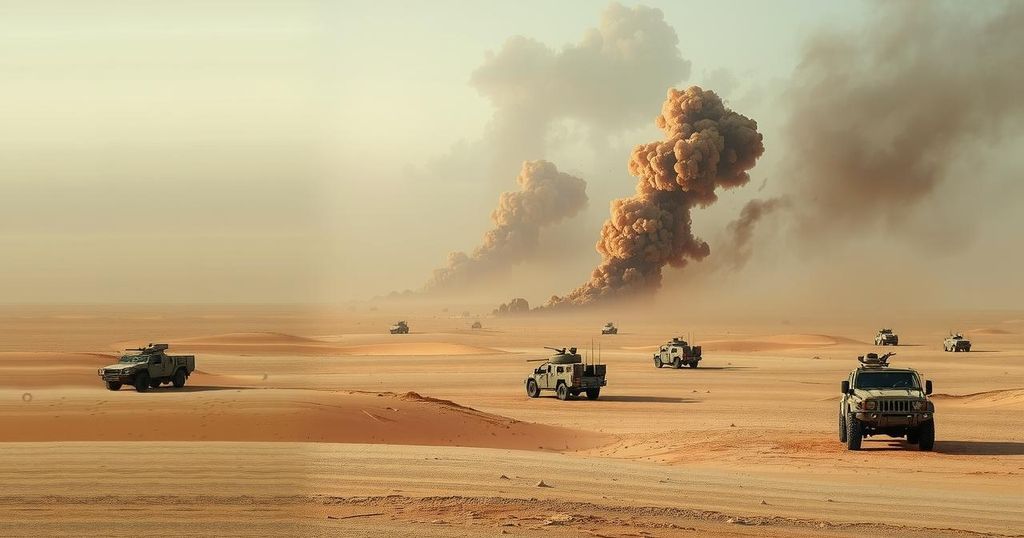Trump’s Regime Change Idea Raises Concerns Amidst Middle East History

President Trump has proposed regime change in Iran, echoing past aggressions in the Middle East. Despite current military actions, history reveals that initial successes in such conflicts often lead to prolonged instability. White House officials suggest that change might emerge internally rather than through direct U.S. intervention, but the risks are substantial and familiar.
As President Donald Trump proposes the idea of regime change in Iran, previous U.S. interventions aimed at remaking the Middle East raise concerns about potential repercussions. Over the weekend, Trump voiced his thoughts on social media, questioning why the current Iranian regime should not be replaced if it fails to improve conditions. This comments came after the U.S. had conducted strikes on Iran’s nuclear sites, prompting a response from Iran, which launched missiles at a U.S. base in Qatar.
White House press secretary Karoline Leavitt defended Trump’s statements. She stressed that the president’s military stance has not shifted significantly, suggesting that a more aggressive strategy might be needed if Iran does not cease its nuclear program or initiate discussions. Leavitt also hinted that a change in the Iranian government could be instigated by its citizens, rather than through direct American intervention. “If they refuse to engage in diplomacy moving forward, why shouldn’t the Iranian people rise up,” she asked.
However, this path carries risks reminiscent of earlier U.S. actions. Trump’s earlier criticisms of prolonged military engagement and nation-building efforts starkly contrast with this renewed rhetoric. Past experiences in the region highlight that initial successes often quickly evolve into long, drawn-out conflicts. For instance, U.S. and Afghan forces successfully ousted the Taliban shortly after the September 11, 2001 attacks, but the ensuing conflict persisted for two decades.
Similarly, the U.S. invasion of Iraq in 2003 led to Saddam Hussein’s overthrow but spiraled into years of violence and chaos. While Trump claims that the recent U.S. airstrikes on Iranian locations have crippled Iran’s nuclear capabilities, a formidable force remains in the Revolutionary Guard and Basij, which have been instrumental in suppressing protests in Iran.
History shows that airstrikes alone cannot replace ground forces; past operations, such as the NATO campaign against Moammar Gadhafi in Libya, underline this fact. Without robust insurgent factions to challenge the Revolutionary Guard and given the formidable size of Iran, a direct invasion seems unlikely.
The internal reactions of ordinary Iranians to a potential regime change remain uncertain. While recent protests indicate many view their government as corrupt, previous attacks, notably the 1980 invasion by Iraq, have often led to nationalistic unity against external threats. Currently, many Iranians appear cautious, some even opting to leave the capital.
Opposition groups abroad also paint a complex picture. Historical precedents show that exiled figures advocating for U.S. intervention can be marginalized upon return, as seen during the Iraq invasion. Although several Iranian opposition movements exist, they lack cohesion and widespread domestic support. Reza Pahlavi, the son of the former Shah, is often considered a unifying figure, yet his relationships could alienate segments of the Iranian population still haunted by past repressions.
Finally, the consequences of regime change in military interventions are frequently catastrophic. The trend in Afghanistan, Iraq, Libya, and other nations indicates that overthrows can lead to civil unrest and emerging extremism from the chaos. Ultimately, past interventions have ended not with stability but often with governments at least as aligned with Iran as they were with U.S. interests.
In light of Trump’s recent comments on Iran, history presents a clear cautionary tale regarding U.S. attempts at regime change. Previous military interventions often resulted in prolonged conflicts, instability, and chaos, rather than the intended democratic transformations. As Tehran faces internal unrest, the desire for change among the Iranian populace does not guarantee success for any foreign-backed actions. Thus, any proposed strategies should be approached with significant caution, considering the potential for unforeseen consequences.
Original Source: apnews.com








